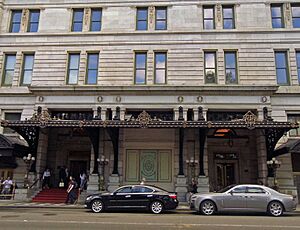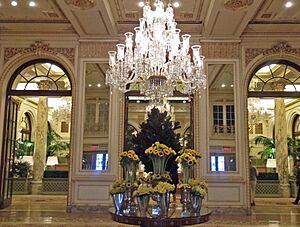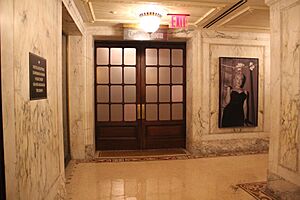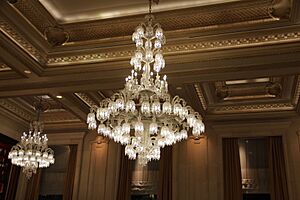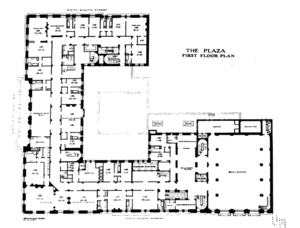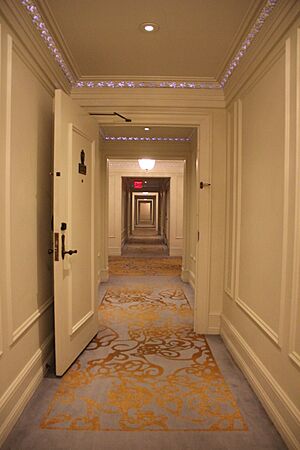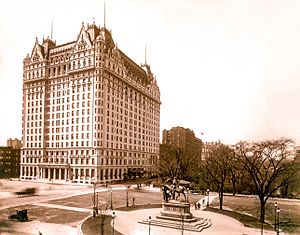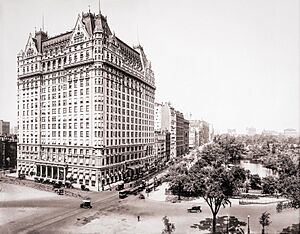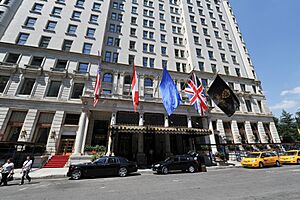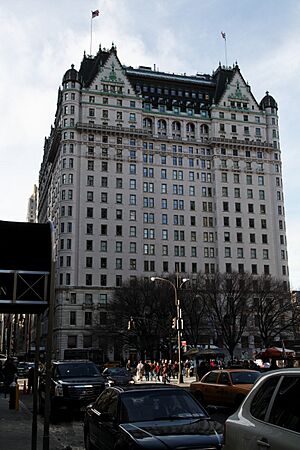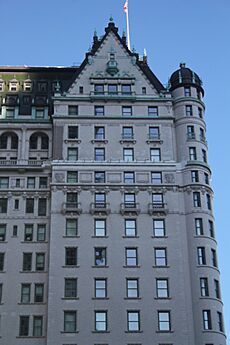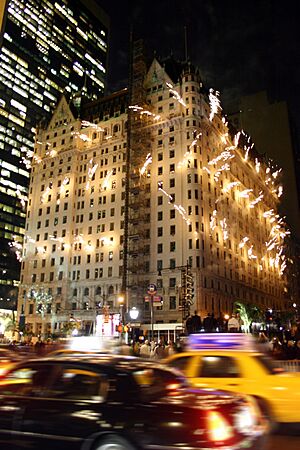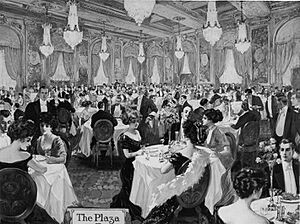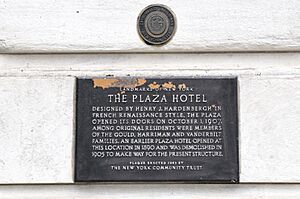Plaza Hotel facts for kids
Quick facts for kids Plaza Hotel |
|
|---|---|
 |
|
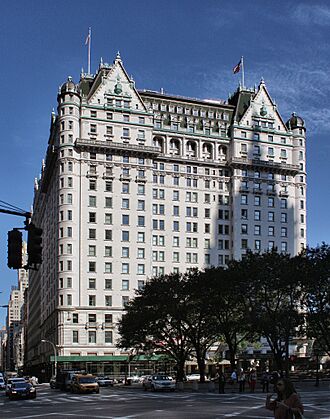
Seen from the corner of 5th Ave. and 58th St.
|
|
| Former names | Westin Plaza |
| Alternative names | The Plaza |
| Etymology | Grand Army Plaza |
| General information | |
| Type | Luxury hotel and condominiums |
| Architectural style | French Renaissance-inspired château style |
| Address | 768 Fifth Avenue Manhattan, New York |
| Coordinates | 40°45′52″N 73°58′28″W / 40.7645°N 73.9744°W |
| Construction started | July 1, 1905 |
| Opened | October 1, 1907 |
| Renovated | 1919–1921 (annex), 1929, 1943–1945, 1964–1965, 2005–2008 |
| Cost | $12.5 million |
| Owner | Katara Hospitality |
| Management | Fairmont Hotels and Resorts |
| Height | 251.92 ft (76.79 m) |
| Technical details | |
| Floor count | 18 |
| Lifts/elevators | 11 |
| Grounds | 53,772 sq ft (4,995.6 m2) |
| Design and construction | |
| Architect | Henry Janeway Hardenbergh (original) Warren and Wetmore (annex) |
| Developer | U.S. Realty Company |
| Main contractor | George A. Fuller Company |
| Other information | |
| Number of rooms | 282 hotel rooms 181 condominiums |
|
Plaza Hotel
|
|
| Location | 768 Fifth Avenue, Manhattan, New York |
| Built | 1907 |
| Architect | Henry J. Hardenbergh; Thomas Hastings, et al. |
| Architectural style | Late 19th and 20th Century Revivals (château style) |
| NRHP reference No. | 78001878 |
| Significant dates | |
| Added to NRHP | November 29, 1978 |
| Designated NHL | June 24, 1986 |
The Plaza Hotel, also known as The Plaza, is a very fancy hotel and apartment building in Midtown Manhattan, New York City. It stands next to Grand Army Plaza, which is where it gets its name. The hotel is also very close to Fifth Avenue and Central Park, making it a famous spot. Its main address is 768 Fifth Avenue. Since 2018, a company from Qatar called Katara Hospitality has owned the hotel.
This amazing 18-story building looks like a French castle, with a style inspired by the French Renaissance. Henry Janeway Hardenbergh was the architect who designed it. The bottom of the building is made of marble, and the upper parts are covered in white brick. A special sloped roof, called a mansard roof, sits on top. Inside, on the ground floor, you'll find beautiful lobbies and several large dining areas. These include the Oak Room, the Palm Court, and the Terrace Room. The floors above have a grand ballroom and many apartments and hotel rooms. After a big update in 2008, the Plaza Hotel now has 282 hotel rooms and 181 private apartments.
The first hotel with the same name was built between 1883 and 1890. The current, much grander building replaced it from 1905 to 1907. Later, from 1919 to 1921, Warren and Wetmore added an expansion. The hotel has had several owners over the years, including famous names like Conrad Hilton and Donald Trump. In 2005, El Ad Properties bought the Plaza and gave it a major renovation. Then, Sahara India Pariwar purchased it in 2012, and Katara Hospitality became the owner in 2018. Since 2005, Fairmont Hotels and Resorts has managed the hotel.
Since it first opened, the Plaza Hotel has become a symbol of New York City. Many rich and famous people have stayed there. Its restaurants and ballrooms have hosted countless special events, like parties, charity events, weddings, and press conferences. People often praise the hotel's beautiful design and its perfect location near Central Park. You might have also seen the Plaza Hotel in many books and movies! The city has even protected its exterior and some interior spaces as official landmarks because of their historical importance. The hotel is also a proud member of Historic Hotels of America.
Contents
- Exploring the Plaza Hotel's Location
- The Plaza Hotel's Design and Look
- A Look at the Plaza Hotel's History
- Famous Faces: Residents and Guests
- The Plaza Hotel's Social Scene
- The Plaza Hotel: A New York City Icon
- See also
Exploring the Plaza Hotel's Location
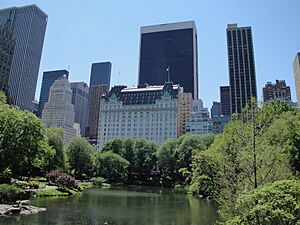
The Plaza Hotel is located at 768 Fifth Avenue and One Central Park South in Midtown Manhattan, New York City. It looks out over Central Park South (which is 59th Street) and Central Park to the north. To the east, it faces Grand Army Plaza. On its south side, it borders 58th Street. The hotel's main entrance looks toward the Pulitzer Fountain in Grand Army Plaza.
The area around Fifth Avenue, between 42nd Street and Central Park South, grew a lot in the late 1800s and early 1900s. Many fancy hotels, stores, and clubs were built there. The Plaza Hotel, along with others like the Savoy and New Netherland hotels, helped make Fifth Avenue a very important and upscale part of the city.
The Plaza Hotel's Design and Look
The Plaza Hotel is a stunning building that looks like a French castle. It stands about 252 feet tall and has 18 stories. The building was designed by Henry Janeway Hardenbergh in 1907. Later, from 1919 to 1922, Warren and Wetmore added an expansion. The beautiful inside areas were mostly designed by these architects, along with Schultze & Weaver.
The Outside Look of the Plaza Hotel
The most detailed parts of the hotel's outside, called the facade, face Central Park to the north and Fifth Avenue to the east. The facade is divided into three main parts, like a tall column: a base, a middle section, and a top. The corners of the hotel are rounded, looking a bit like small towers. You can see many decorative features like balconies, columns, and arches all over the building.
The Base of the Building
The first two floors of the hotel are covered with large, rough-cut blocks of marble. The third floor has smooth marble. The hotel originally had two main entrances. One was on Central Park South, and a more private one was on 58th Street for people living there long-term. After a 2008 renovation, the Central Park South entrance became the main way into the building's private apartments.
The side facing Grand Army Plaza once had a special outdoor area called the Champagne Porch. This porch was replaced in 1921 by a grand central entrance. This entrance features six tall columns that support a balcony above.
The Upper Stories and Roof
The floors from the fourth to the fifteenth are covered with white brick and have rectangular windows. These sections also have decorative terracotta details that match the marble below and the roof above.
The top three floors are part of a green, tiled mansard roof with copper decorations. This roof has many dormer windows. The rounded corners of the hotel are topped with green domed roofs, designed to match the trees in Central Park. A very large apartment, called a penthouse, takes up the top three floors.
How the Hotel Works: Mechanical Features
The Plaza Hotel was very modern for its time. It originally had a system of tubes to send mail and food orders around the hotel. It also had many elevators for guests and staff. The hotel had large tanks to store water and could filter a huge amount of water every day for its guests.
Deep in the basement, the hotel had a powerful system to generate its own electricity and keep things cool. It even had a plant that could make ice! All these systems helped the hotel run smoothly and provide excellent service to its guests.
Inside the Plaza Hotel: A Look Around
The hotel has a strong steel frame. Inside, five marble staircases originally connected the ground floor to all the other levels. The main lobby was considered the most important space in the hotel.
The hotel also had laundry rooms and staff quarters. In the basement, there was a grill room, kitchens, and even a barber shop.
Grand Hallways and Lobbies
On the ground floor, a main hallway connects all the important areas. This hallway wraps around the Palm Court, which is in the middle of the floor. All the hallways have beautiful mosaic floors, decorated ceilings, and marble columns.
The Central Park South entrance used to be the main lobby. It has French marble walls, shiny bronze decorations, and a mosaic floor. A sparkling crystal chandelier hangs from the ceiling.
Later, the Grand Army Plaza lobby, also called the Fifth Avenue lobby, became the hotel's new main entrance. It has a U-shaped balcony above and kept some of the original fancy decorations.
Delicious Dining: Ground-Floor Restaurants
The Oak Room, located on the west side of the ground floor, was originally the bar room. It still looks much like it did when it first opened. It has oak walls and floors, paintings of Bavarian castles, and a chandelier shaped like grapes.
Just north of the Oak Room is the Oak Bar. It has a Tudor-style design with walnut wood and French furniture. Three murals by Everett Shinn show what the neighborhood looked like in 1907.
The Edwardian Room, at the northeast corner, is a large dining space. It has dark oak paneling and mosaic tile floors. Large windows and bronze chandeliers light up the room.
The Palm Court, in the center of the ground floor, was inspired by a famous hotel in London. It has stone walls, mosaic floors, and marble columns. Tropical plants and palm trees give it a garden-like feel. Its beautiful stained glass ceiling was removed in the 1940s but was restored in the mid-2000s.
The Terrace Room, built in 1921, is named for its three raised sections, like terraces. It features Renaissance-style decorations, chandeliers, and marble walls. This room is often used for special events.
The Grand Ballroom
The hotel's main ballroom is on the first floor (which is actually the second story). It was designed by Warren and Wetmore and could hold many people for dinners and dances. It has a beautiful ceiling and six chandeliers.
In 1929, the ballroom was updated with a new, classic design by Schultze & Weaver. It now has a white and cream color scheme with gold decorations. This grand room is perfect for large celebrations and events.
Living in Luxury: Condominiums and Suites
The Plaza Hotel's private apartments and suites start on the third story. Originally, they came in different sizes, from one-bedroom to larger suites with parlors. The rooms were decorated with wooden details and crystal chandeliers. Guests could even order meals to their rooms using a special system.
After the 2008 renovation, the building now has 181 privately owned apartments, called the Plaza Residences. These apartments are on the north and east sides of the building and range from small studios to huge penthouses. They have beautiful wood floors and stone counters, keeping the hotel's original fancy style.
There are also 282 hotel units on the southern side. Some of these are "condo-hotel" units, which means investors can live there for part of the year and rent them out as hotel rooms the rest of the time. Other rooms are just for short-term hotel stays. The hotel still offers a butler on each floor, just like in its early days, to make guests feel extra special.
Some very fancy suites were designed over the years. For example, in 2013, a suite was decorated with items from The Great Gatsby movie, based on the famous book. In 2017 and 2018, the hotel offered special vacation packages based on the movie Home Alone 2: Lost in New York, which was partly filmed there.
A Look at the Plaza Hotel's History
The land where the Plaza Hotel stands was first sold by New York City in 1853. The first building planned for this spot in 1882 was an apartment building, but it was never finished.
The First Plaza Hotel
In 1883, John Duncan Phyfe and James Campbell started building a nine-story apartment building. However, they faced financial challenges and couldn't complete it. The New York Life Insurance Company took over and decided to turn it into a hotel. They hired architects McKim, Mead & White to finish the inside.
The first Plaza Hotel opened on October 1, 1890. It had eight stories and 400 rooms. The inside was decorated with lots of mahogany wood and carved details. Even though it was considered very fashionable, it didn't make much money at first.
Building the Grand Plaza Hotel We See Today
By the early 1900s, the area around the Plaza Hotel was becoming very popular. In 1902, a group of investors bought the Plaza and nearby land. They were led by Harry S. Black and German financier Bernhard Beinecke. They decided to build a brand new, much grander hotel.
Construction of the New Hotel
Henry J. Hardenbergh was hired as the architect in 1905. He had designed other famous hotels before. The builders soon realized the old hotel's foundation couldn't support the new plans, so they decided to tear it down completely and build from scratch. The George A. Fuller Company was hired for construction.
The old Plaza Hotel closed on June 11, 1905, and demolition began right away. The new hotel used a huge amount of steel. Workers built two stories of steelwork every six days! The inside was custom-designed with 1,650 crystal chandeliers and special cutlery. The new hotel cost about $12.5 million to build.
Opening and Early Years
The new 800-room Plaza Hotel opened on October 1, 1907. Many famous people attended the opening, including businessman Diamond Jim Brady and author Mark Twain. Even though there was a financial panic that year, the hotel did well. It was designed for many long-term residents, with only a small number of rooms for short stays.
The hotel quickly became a very exclusive place. The Champagne Porch, a special outdoor area, was known for its very expensive meals. The Plaza Hotel employed over 1,500 staff members in its first ten years.
From 1919 to 1922, the hotel added a large expansion along 58th Street, designed by Warren and Wetmore. This work included a new restaurant, the Terrace Room, and a larger ballroom. The main entrance was also moved to Grand Army Plaza.
Challenges During the Great Depression
In 1929, the ballroom was redesigned. Soon after, the Great Depression began, causing financial difficulties for many businesses, including the Plaza Hotel. One of the hotel's co-owners, Harry Black, passed away the following year. The hotel struggled, with many rooms empty and furnishings falling into disrepair.
Despite these challenges, the hotel continued to adapt. The old tea room became known as the Palm Court. The Oak Room restaurant reopened in 1934, becoming a popular spot for bankers and brokers.
Mid-20th Century Changes
Hilton Takes Over
In 1943, hotelier Conrad Hilton bought the Plaza Hotel for $7.4 million. He then spent $6 million to refurbish the hotel. During this time, the Fifth Avenue lobby was renovated, and the Palm Court's skylight was replaced with air conditioning. The Oak Bar, which had been an office, reopened in 1945.
By the early 1950s, the rules about who could enter certain rooms changed. Women were allowed in the Oak Room and Bar during evenings and in the summer. Hilton sold the hotel in 1953, but it continued to be managed by hotel companies.
Sonnabend's Management
The hotel faced some financial difficulties in the early 1960s, but things improved under the management of A.M. "Sonny" Sonnabend. The hotel's exterior was cleaned for the first time since it was built in 1960. Many rooms and public areas were redecorated. In 1964, Sonny Sonnabend passed away, and his son Roger took over. The rule that only men could have lunch at the Oak Room ended in 1969.
The Plaza in the Late 20th Century
Westin Hotels Ownership
In 1974, Westin Hotels bought the Plaza Hotel for $25 million. They spent $200 million to renovate the hotel, cleaning the outside and restoring many of the original designs inside. The old hydraulic elevators were replaced with modern electric ones. The famous Shinn murals in the Oak Bar were also purchased by Westin.
By the late 1970s, the Plaza Hotel was making a profit again. Westin Hotels renamed it The Westin Plaza in 1981.
Donald Trump's Ownership
In 1988, real estate developer Donald Trump bought the Plaza. His wife, Ivana Trump, was put in charge of renovating and managing the hotel. They focused on restoring the lobby and other interior spaces, adding gold details and new carpets.
However, the hotel faced significant financial challenges during this time, and its owners worked to manage its debts. In 1992, to help with these challenges, Trump reached an agreement with the hotel's lenders.
New Owners: Kwek and Al-Waleed
In 1995, Donald Trump sold a controlling share of the Plaza to Kwek Leng Beng from Singapore and Saudi prince Al-Waleed bin Talal. They each bought a large part of the hotel. The Plaza became very profitable in the late 1990s.
The Plaza Hotel in the 21st Century
El Ad Properties Takes Over
After the events of September 11, 2001, tourism in New York City slowed down. In 2004, El Ad Properties bought the Plaza Hotel for $675 million. El Ad wanted to add more apartments and stores, which led to discussions with hotel unions and preservation groups. They eventually agreed on a plan that would convert some hotel rooms into apartments while keeping many hotel suites and preserving the historic restaurant spaces.
The Plaza Hotel closed temporarily for a $450 million renovation on April 30, 2005. Fairmont Hotels and Resorts began operating the hotel part of the building. During the renovation, many hotel rooms became residential units, and the Palm Court's beautiful stained glass ceiling was restored.
The hotel officially reopened on March 1, 2008. It also opened an underground mall with luxury brands and a food hall. However, the Oak Room restaurant closed in 2011.
Sahara India and Katara Hospitality
In 2012, Sahara India Pariwar bought a large share of the hotel. However, Sahara also faced legal issues. In 2017, after trying to find a buyer, Sahara hired a broker to sell the hotel.
In July 2018, Katara Hospitality, a hotel company from Qatar, bought full ownership of the Plaza Hotel. Under Katara's ownership, the private apartments continued to be very expensive. Due to the COVID-19 pandemic, the hotel rooms temporarily closed in March 2020. The Plaza Hotel officially reopened in May 2021, with public spaces adjusted for safety.
Famous Faces: Residents and Guests
Who Lived at the Plaza Hotel?
When the current Plaza Hotel opened in 1907, the first person to sign the guest book was Alfred Gwynne Vanderbilt, a very wealthy man. Other rich residents included George Jay Gould. John Warne Gates, one of the hotel's developers, had a large 16-room apartment. Russian princess Vilma Lwoff-Parlaghy, a famous painter, even lived in a suite with her lion! The hotel was popular with the wealthy because it was fancy and faced Central Park.
Later, the Plaza was home to many "wealthy widows," including performer Kay Thompson, who wrote the famous Eloise children's books about a young girl living at the hotel.
After many units became private apartments in 2008, the Plaza Hotel became even more sought after by rich people. Many famous executives and designers, like Robert Kraft (owner of the New England Patriots) and fashion designer Tommy Hilfiger, have owned apartments there.
Who Stayed at the Plaza Hotel?
Many famous people have stayed in the hotel's guest rooms. These include opera singer Enrico Caruso and novelists F. Scott Fitzgerald and Zelda Fitzgerald. Architect Frank Lloyd Wright often stayed at the Plaza while designing the Solomon R. Guggenheim Museum.
Even the Beatles stayed at the Plaza Hotel during their first visit to the United States in February 1964!
The Plaza Hotel's Social Scene
From its opening, the Plaza Hotel became a hotspot for celebrities and wealthy people. The Palm Court, especially, was a popular place for social gatherings. In 1908, crowds gathered to see heiress Gladys Vanderbilt having tea there. The New York World newspaper even called the hotel the "Home-for-the-Incurably Opulent."
During the 1920s, the basement's grill room was a popular meeting spot for young adults. The Oak Room was a favorite of actor George M. Cohan. The Persian Room was a trendy nightclub, attracting socialites and famous performers like Eartha Kitt and Liza Minnelli.
The hotel has also hosted many world leaders, including U.S. presidents. Theodore Roosevelt moved his political party's events to the Plaza. His cousin, president Franklin D. Roosevelt, had his birthday lunch in the Palm Court in 1935. Other presidents like William Howard Taft and Richard Nixon also visited. In 1970, a visiting official from Taiwan was involved in an incident where someone tried to harm him at the hotel.
The Plaza Hotel has also been the site of important diplomatic events. In 1985, finance ministers from several countries signed the Plaza Accord there, an agreement about international money. The hotel also hosted the NBA draft several times in the 1960s and 1970s.
Special Events and Receptions
The Terrace Room has often been used for press conferences and receptions. For example, in 1956, Laurence Olivier and Marilyn Monroe talked about their upcoming film there. When the Beatles stayed at the hotel in 1964, visitors could take pictures with them in the Terrace Room.
Grand Benefits and Weddings
The Grand Ballroom quickly became a popular place for fancy parties and charity events after it opened in 1921. It hosted a dinner honoring scientist Marie Curie in 1929 and a meeting attended by U.S. first lady Eleanor Roosevelt in 1935. After World War II, it continued to be a favorite spot for charity balls. Writer Truman Capote hosted his famous "Black and White Ball" there in 1966.
The Grand Ballroom and Terrace Room have also been chosen for many weddings and wedding receptions. For instance, the reception for figure skater Sonja Henie's wedding was in the Terrace Room in 1949. Donald Trump and Marla Maples had their wedding in the ballroom in 1993. In 2000, actors Michael Douglas and Catherine Zeta-Jones also got married at the Plaza.
The Plaza Hotel: A New York City Icon
The Plaza Hotel has truly become a symbol of New York City. Many people, including historians, say it's an important part of the city's history, just like Grand Central Terminal. The National Trust for Historic Preservation has recognized the Plaza Hotel as a Historic Hotel of America.
Protecting a Landmark: Designations
After a nearby hotel was torn down in 1964, people wanted to protect the Plaza Hotel. This led to the hotel's exterior being named a city landmark in 1969. It was added to the National Register of Historic Places in 1978 and became a National Historic Landmark in 1986.
In 2005, a large part of the hotel's main public spaces inside—including the lobbies, ballroom, and restaurants—were also made New York City landmarks. This was done partly to protect these beautiful rooms from being changed into stores during a renovation.
See also
 In Spanish: Hotel Plaza para niños
In Spanish: Hotel Plaza para niños


